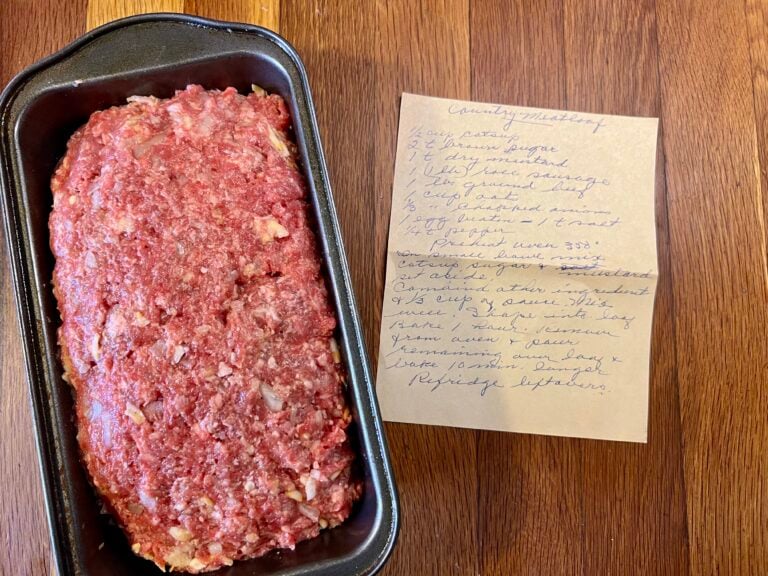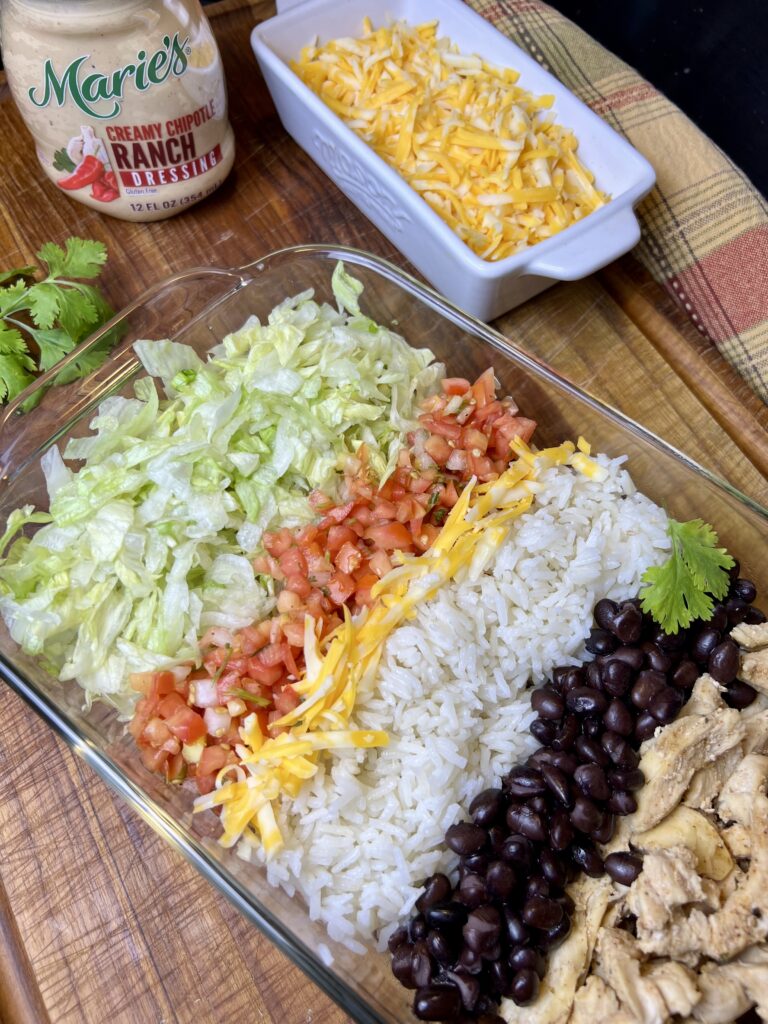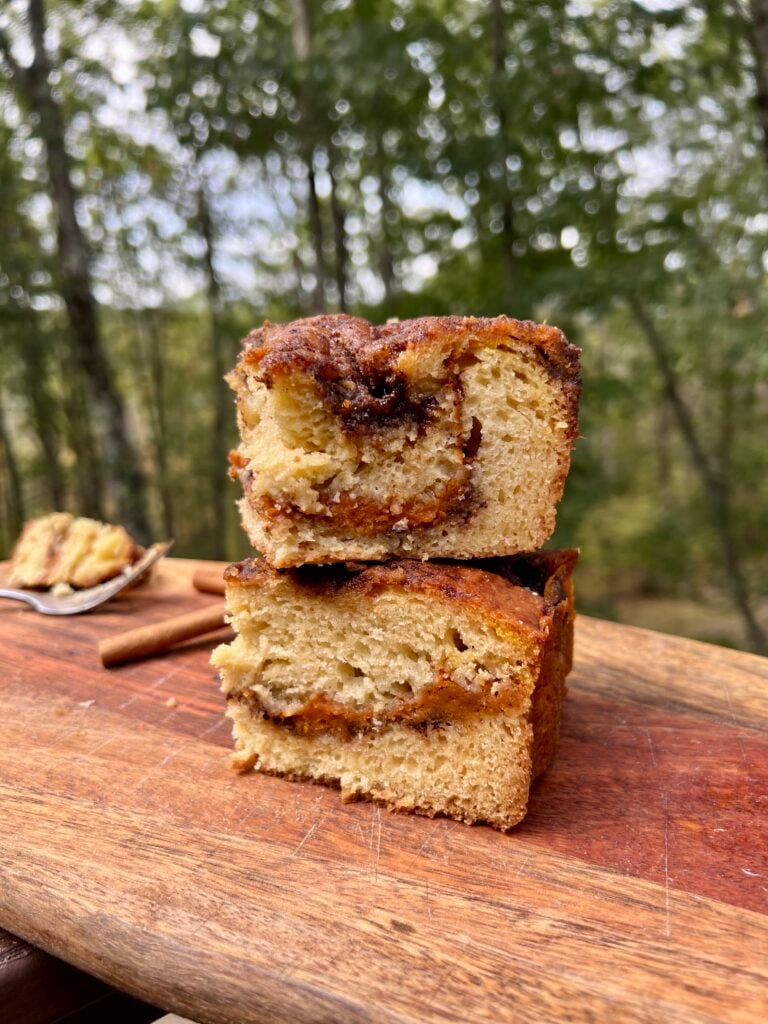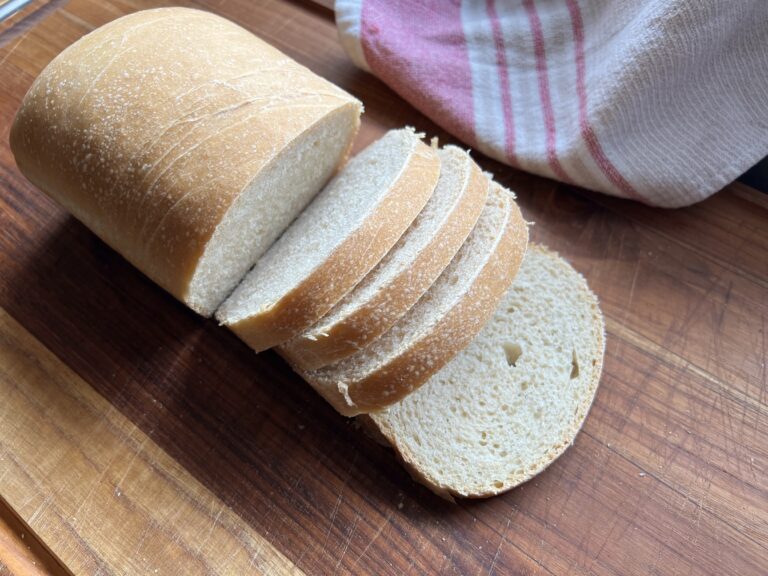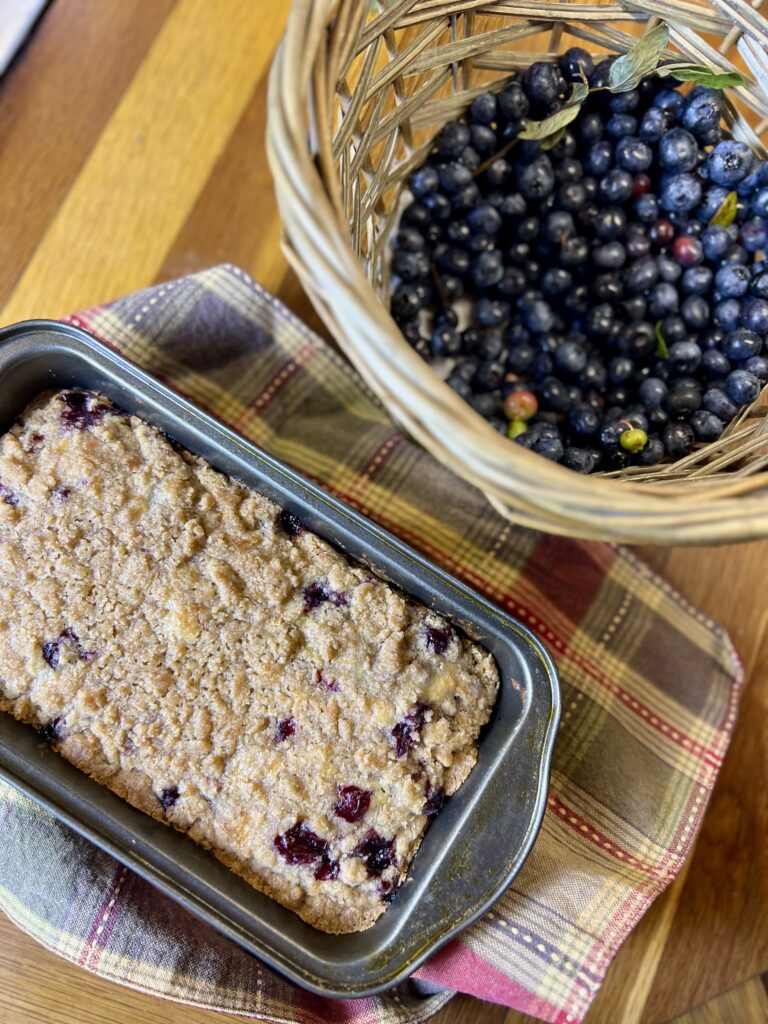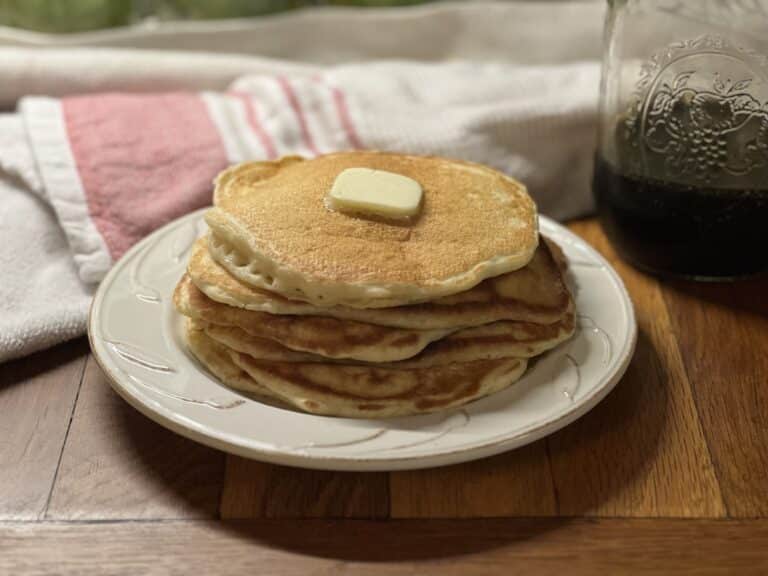Sourdough Bagels: The Best Homemade Bagels
If you’re craving chewy, flavorful, and perfectly golden sourdough bagels, this from-scratch recipe lets you nourish your family with wholesome, real ingredients, right from your own kitchen.
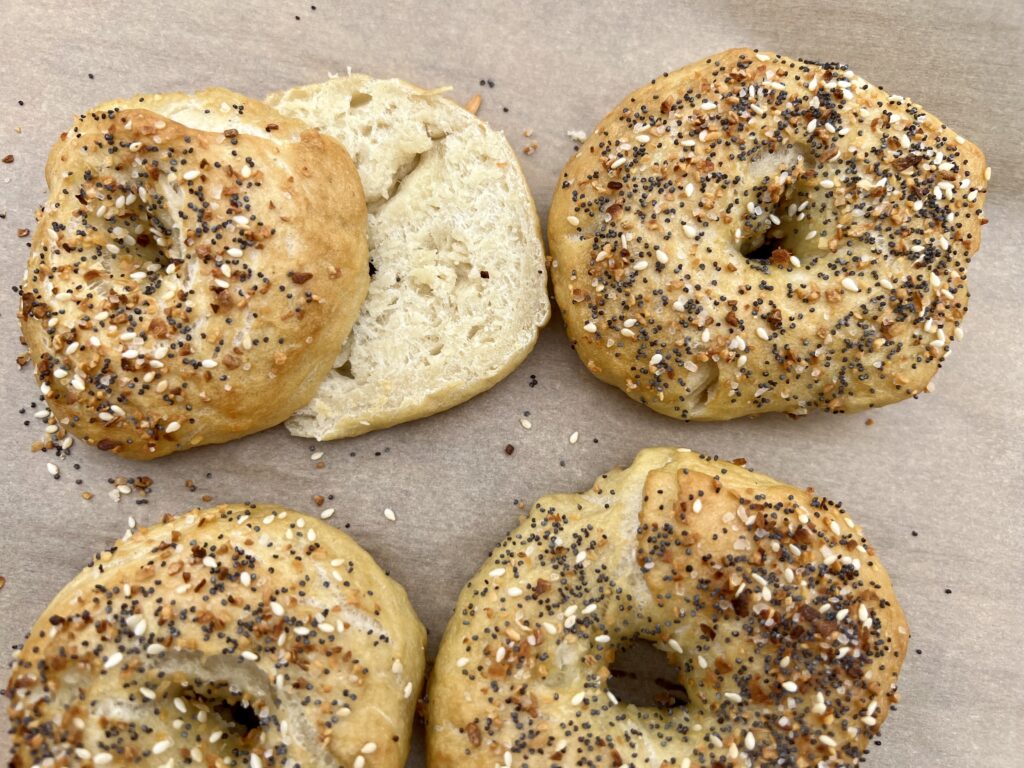
Using natural fermentation, these bagels are healthier, easier to digest, and incredibly delicious! The long fermentation process breaks down gluten and phytic acid, making nutrients more bioavailable and the bagels easier on your gut.
Whether you’re new to sourdough baking or a seasoned baker, I am excited to walk you through how to make sourdough bagels at home!
And once you’ve mastered these classic sourdough bagels, be sure to try my sourdough blueberry bagels for a fruity twist or these irresistible sourdough soft pretzels for a salty, chewy snack your whole family will love.
Why Make Sourdough Bagels?
Sourdough bagels are made with a naturally fermented dough using a sourdough starter instead of commercial yeast. This slow fermentation process develops a deeper flavor and creates the signature chewy texture that sets a good bagel apart.
Health Benefits of Sourdough
Sourdough is easier to digest than conventional breads thanks to the natural fermentation process, which:
- Breaks down gluten and phytic acid
- Makes nutrients more bioavailable
- Supports gut health through prebiotics
Plus, baking sourdough bagels from scratch at home means you can avoid unnecessary additives and preservatives.
Ingredients You’ll Need
Here’s everything you need to make these from scratch sourdough bagels:
Levain (or active sourdough starter):
- 100g active sourdough starter (fed and bubbly)
Dough:
- 500g (4 cups) bread flour
- 275g (1 1/8 cups) warm water
- 100g active sourdough starter
- 10g (1 tbsp) sugar or honey
- 10g (1 ½ tsp) salt
Boiling Water Bath:
- 3 tbsp brown sugar
- 1 tbsp baking soda
- 1 tsp salt
Optional Toppings:
- Sesame seeds
- Poppy seeds
- Everything bagel seasoning
- Shredded cheese
- Dried onion or garlic flakes
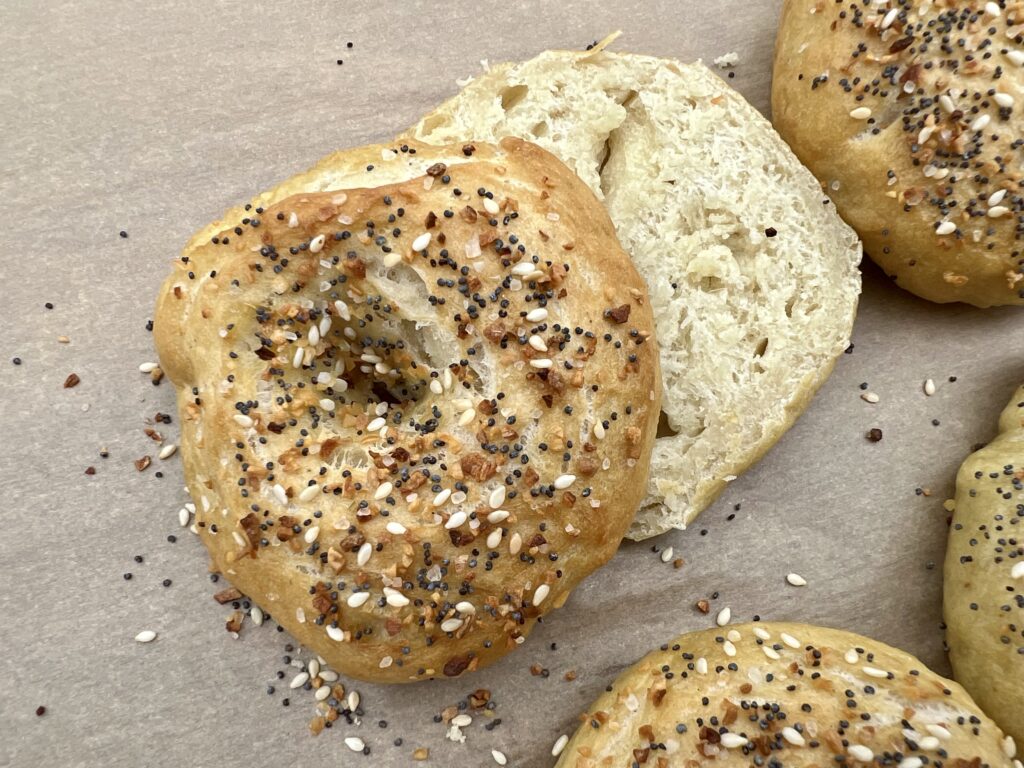
How to Make Sourdough Bagels: Step-by-Step Instructions
This recipe uses long fermentation for maximum flavor and texture. Plan to mix your dough in the evening, ferment overnight, and bake the next morning.
1. Mix and Autolyse (Evening)
In a large mixing bowl, combine the flour and warm water until just incorporated. Don’t add the starter, salt, or sweetener yet, just the flour and water. Cover the bowl with a damp towel and let it rest for 30 minutes.
What is Autolyse?
Autolyse is a simple but important step in sourdough baking where only the flour and water are mixed and allowed to rest before adding any other ingredients.
This resting period gives the flour time to fully absorb the water and begin developing gluten naturally. It makes the dough easier to knead, improves texture, and helps create that perfect chewy crumb in your finished bagels.
2. Add Starter, Salt, and Sweetener
After the autolyse, add 100g of active sourdough starter, 10g salt, and 10g sugar or honey. Mix well, then knead for 8–10 minutes by hand or with a dough hook. The dough should be smooth, elastic, and slightly stiff, but not sticky.
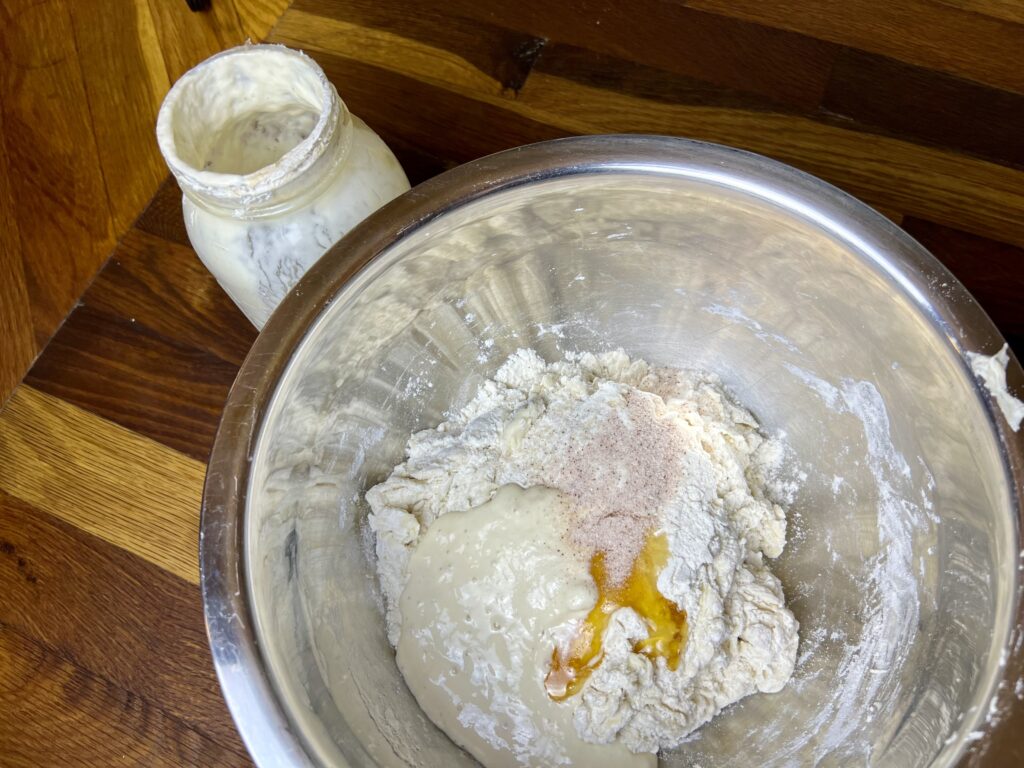
3. Bulk Ferment Overnight
Cover the bowl with a damp cloth or lid and allow the dough to ferment at room temperature for 8–10 hours. The dough will puff up slightly, but it doesn’t need to double in size.
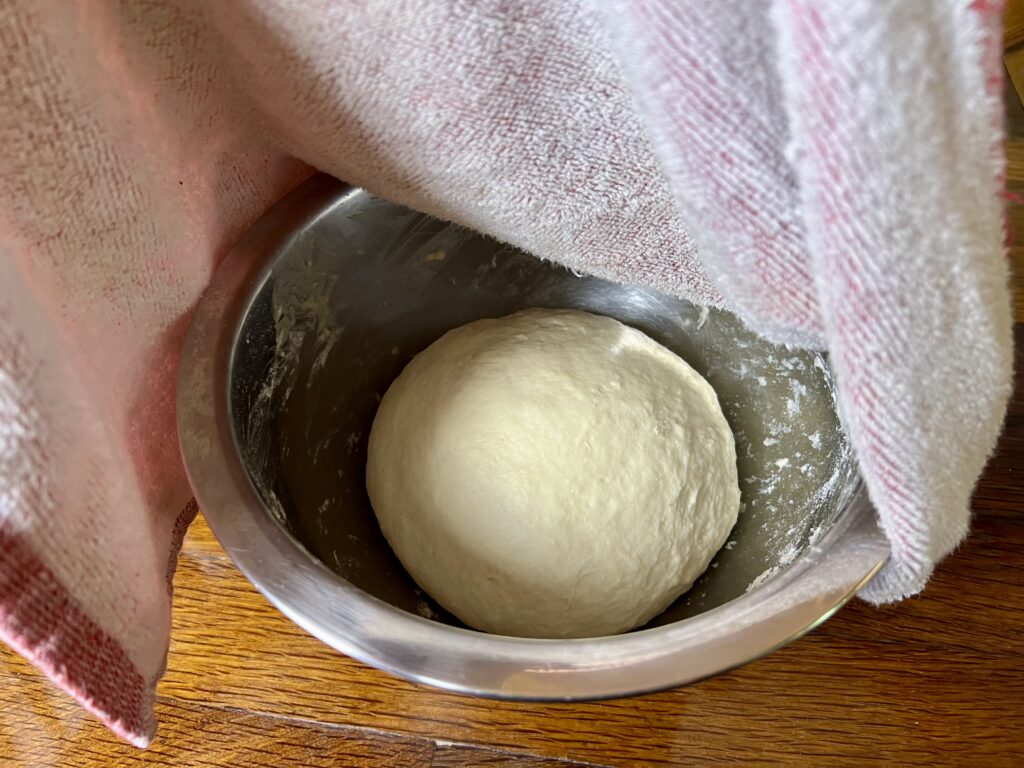
4. Shape the Bagels (Morning)
Turn the dough out onto a lightly floured surface. Divide into 8–10 equal pieces and roll each into a tight ball. Poke a hole in the center of each ball using your finger and gently stretch it into a ring shape.
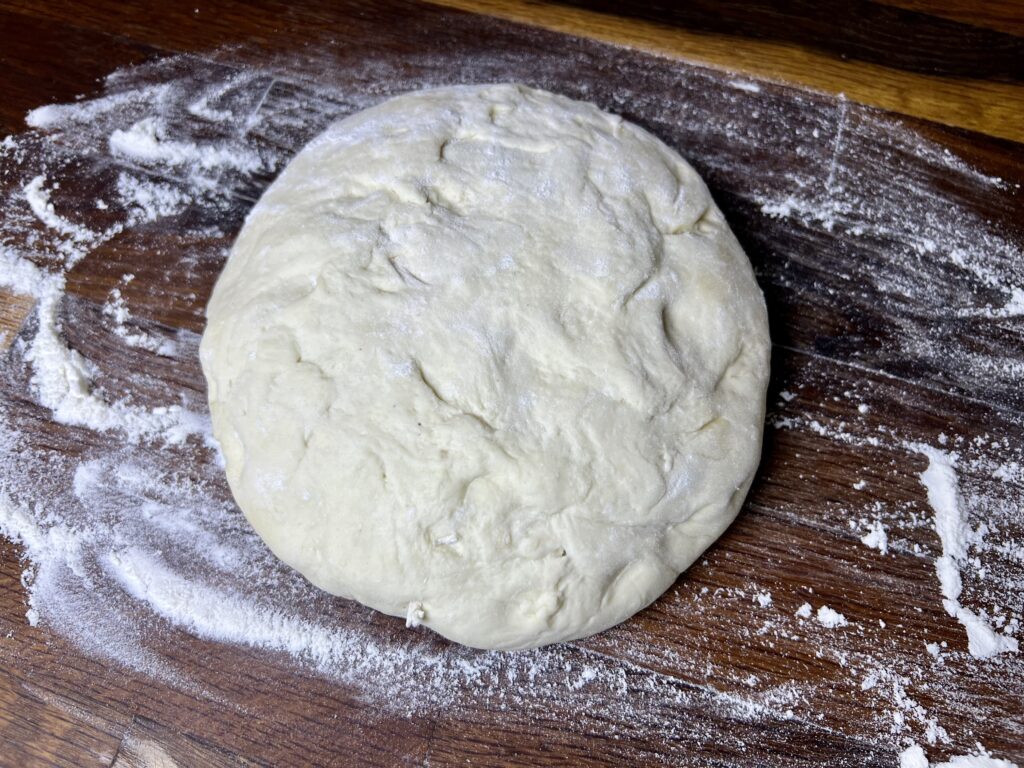

Place shaped bagels on a parchment-lined baking sheet. Cover with a towel and let them rest for 30–60 minutes while you bring a large pot of water to a boil.
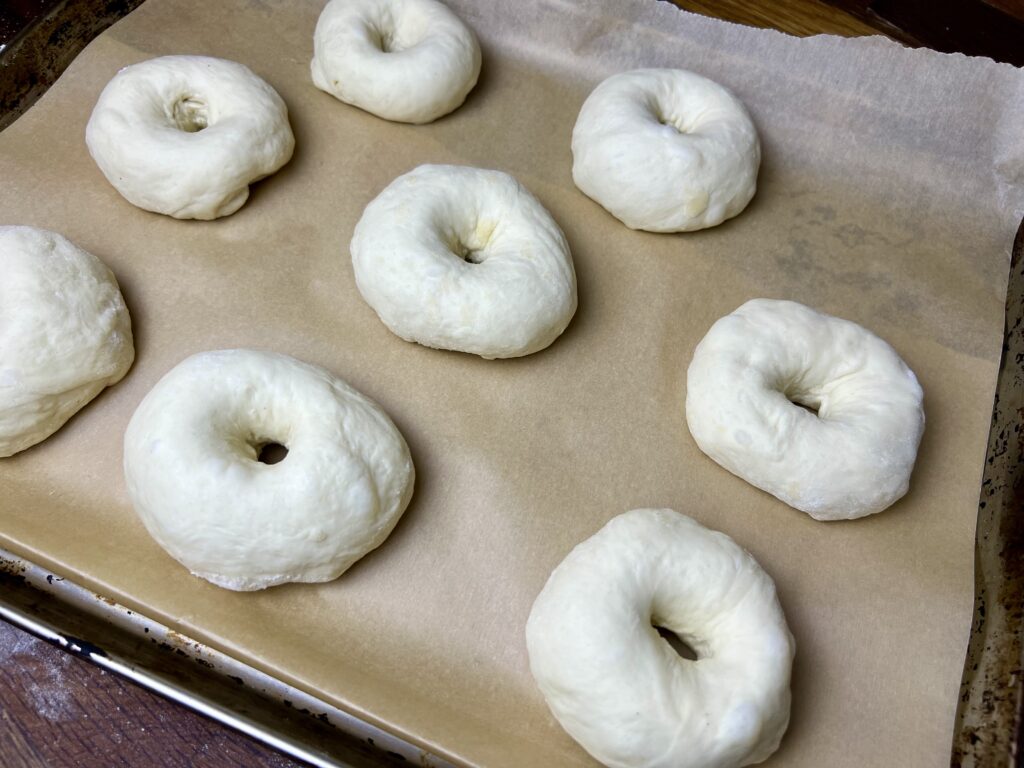
5. Boil the Bagels
Preheat your oven to 425°F (220°C).
To the boiling water, add:
- 3 tablespoons brown sugar
- 1 tablespoon baking soda
- 1 teaspoon salt
Gently drop 2–3 bagels at a time into the boiling water. Boil each side for 2 minutes. This step gives the bagels their signature chew and helps the crust form during baking.
Use a slotted spoon to transfer the boiled bagels back to the baking sheet. If you want toppings, add them now while the bagels are still damp.
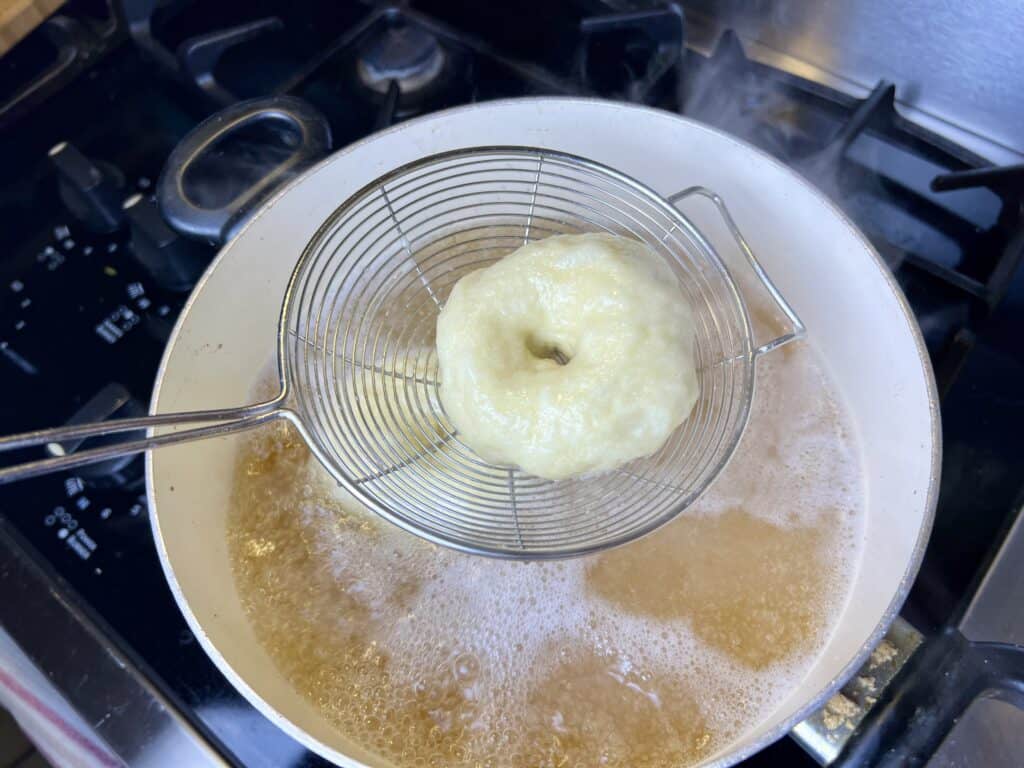
6. Bake
Bake for 20–25 minutes or until the bagels are golden brown. Rotate the tray halfway through baking to ensure even browning. Cool on a wire rack before slicing or storing.
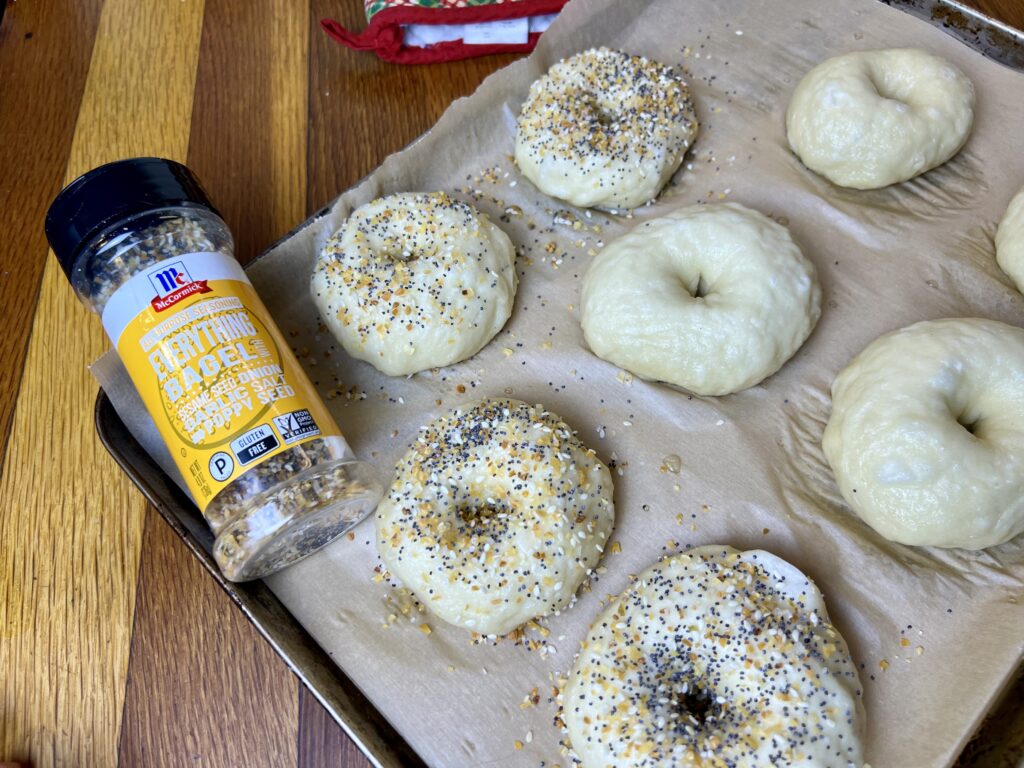
Storage Tips
- Room Temperature: Store cooled bagels in an airtight container for 2–3 days.
- Freezing: Slice and freeze in a zip-top bag for up to 3 months. Toast straight from frozen for a quick breakfast.

Bagel Topping Ideas
Customize your bagels with these classic topping options:
- Everything bagel seasoning
- Sesame or poppy seeds
- Shredded cheddar or asiago cheese
- Cinnamon sugar – Sprinkle before baking for a sweet touch
- Dried onion or garlic flakes – Add savory flavor and crunch
Tips for the Best Sourdough Bagels
- Don’t skip the boil! It sets the crust and gives bagels their signature chew.
- Keep your starter active. A bubbly, well-fed starter gives the dough the strength it needs to rise.
- Shaping matters. Make sure the center hole is large enough, it will shrink during baking.
FAQ: Sourdough Bagels
Can I make sourdough bagels without bread flour?
Yes, but the texture will be softer and less chewy. Bread flour has a higher protein content that’s ideal for bagels.
How do I know when my dough has fermented enough overnight?
It should look puffy and feel slightly airy when pressed. It won’t double in size, but you should notice a visible rise.
Why do you boil bagels before baking?
Boiling sets the crust and gives the bagels their dense, chewy texture. Adding baking soda and sugar to the water helps them brown beautifully in the oven.
Can I cold-proof these bagels overnight in the fridge?
Yes! After shaping, you can refrigerate the bagels overnight (covered). Boil and bake straight from the fridge the next morning. This can improve flavor and texture even more.
Why Are My Sourdough Bagels Flat?
Flat sourdough bagels are usually caused by over proofing or a weak starter. If your dough ferments for too long, it can lose structure and collapse when boiled or baked. Also, make sure your starter is bubbly and active. It should float in water before you mix your dough. Proper gluten development during kneading and careful shaping also help create a, chewy bagel.
Can You Over proof Sourdough Bagels?
Yes! Over proofing is one of the most common reasons for flat or gummy bagels. When the dough ferments too long, the gluten weakens and the bagels may deflate during boiling. To prevent this, make sure your dough is only slightly puffed after bulk fermentation and again after shaping, not doubled in size.
What Do Sourdough Bagels Taste Like?
Sourdough bagels have a chewy texture and a slightly tangy flavor from natural fermentation. They’re less sweet than store bought bagels and have a richer flavor. The crust is golden and slightly crisp, while the inside is soft and chewy, just as a bagel should be!
Are Sourdough Bagels Healthy?
Yes! Sourdough bagels made with natural fermentation have several health benefits:
- Easier to digest due to broken-down gluten and phytic acid
- Lower glycemic index than conventional bagels
- Richer in nutrients thanks to enhanced mineral absorption
- Fewer preservatives and additives when made at home
Are Sourdough Bagels Healthier Than Regular Bagels?
Sourdough bagels are generally considered healthier than regular bagels because the natural fermentation process improves digestion, lowers blood sugar spikes, and promotes gut health. They’re also a great option if you’re trying to avoid commercial yeast or processed ingredients.
What’s the Difference Between Sourdough Bagels and Regular Bagels?
The main difference is in the leavening. Sourdough bagels are naturally fermented with wild yeast and beneficial bacteria, while regular bagels use commercial yeast. This leads to:
- More flavor (slightly tangy)
- Better digestion
- Longer shelf life
- Healthier nutritional profile
What Is the Healthiest Bagel to Eat?
The healthiest bagel is one made with whole grains, natural leavening (like sourdough), and minimal added sugars. Homemade sourdough bagels with freshly milled whole wheat flour is the healthiest option.
Final Thoughts
Homemade sourdough bagels are a true labor of love, but the result is worth every step. Once you try your first warm, chewy bagel fresh from the oven, you’ll never want to go back to store-bought again.
Whether you enjoy yours plain, topped with everything seasoning, or slathered in cream cheese, this sourdough bagel recipe is a keeper for any home baker.

Sourdough Bagels
Chewy, golden, and naturally fermented, these homemade sourdough bagels are everything you love about a bakery bagel, made with simple, wholesome ingredients. This recipe skips commercial yeast and uses an active sourdough starter for better digestion, richer flavor, and a beautiful crust. Perfect for breakfast, lunch, or to freeze for later!
Ingredients
Levain (or active sourdough starter):
- 100g active sourdough starter (fed and bubbly)
Dough:
- 500g (4 cups) bread flour
- 275g (1 1/8 cups) warm water
- 100g active sourdough starter
- 10g (1 tbsp) sugar or honey
- 10g (1 ½ tsp) salt
Boiling Water Bath:
- 3 tbs brown sugar
- 1 tbsp baking soda
- 1 teaspoon salt.
- Optional Toppings: Sesame seeds, poppy seeds, everything bagel seasoning, shredded cheese, etc
Instructions
1. Mix and Autolyse (Evening)
In a large bowl, mix the flour and water until just combined. Cover and let rest for 30 minutes. This helps hydrate the flour.
2. Add Starter, Salt, and Sweetener
Add the sourdough starter, salt, and sugar or honey. Knead by hand or with a dough hook for 8–10 minutes until the dough is smooth and elastic. It should be stiff, not sticky.
3. Bulk Ferment (Overnight)
Cover the bowl with a damp towel or lid. Let it ferment at room temperature for 8–10 hours, or until the dough is puffed up (but not doubled).
4. Shape the Bagels (Morning)
Turn the dough out onto a lightly floured surface. Divide into 8–10 pieces. Roll each into a ball, poke a hole in the center with your finger, and gently stretch into a ring.
Place shaped bagels on a parchment-lined baking sheet. Cover with a towel and let rest for 30–60 minutes while you bring a large pot of water to a boil.
5. Boil the Bagels
Preheat your oven to 425°F (220°C).
Add baking soda and honey to the boiling water. Drop 2–3 bagels at a time into the boiling water. Boil for 2 minutes per side, then remove with a slotted spoon.
Return boiled bagels to the baking sheet. Add toppings now if desired.
6. Bake
Bake for 20–25 minutes until golden brown, rotating the tray halfway through. Cool on a wire rack before slicing.
Notes
- Store in an airtight container for 2–3 days.
- Freeze extras in a zip-top bag for up to 3 months. Toast straight from frozen.
Nutrition Information
Yield 8 Serving Size 1Amount Per Serving Calories 196Total Fat 4gSaturated Fat 1gTrans Fat 0gUnsaturated Fat 2gCholesterol 4mgSodium 866mgCarbohydrates 36gFiber 2gSugar 7gProtein 6g
Nutrition information is automatically calculated, so should only be used as an approximation.


